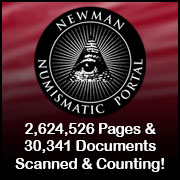
About UsThe Numismatic Bibliomania Society is a non-profit association devoted to the study and enjoyment of numismatic literature. For more information please see our web site at coinbooks.org SubscriptionsThose wishing to become new E-Sylum subscribers (or wishing to Unsubscribe) can go to the following web page link MembershipThere is a membership application available on the web site Membership Application To join, print the application and return it with your check to the address printed on the application. Print/Digital membership is $40 to addresses in the U.S., and $60 elsewhere. A digital-only membership is available for $25. For those without web access, write to: Charles Heck, Treasurer
AsylumFor Asylum mailing address changes and other membership questions, contact Chuck at this email address: treasurer@coinbooks.org SubmissionsTo submit items for publication in The E-Sylum, write to the Editor at this address: whomren@gmail.com BUY THE BOOK BEFORE THE COIN |
- WAYNE'S WORDS: THE E-SYLUM AUGUST 28, 2019
- GEORGE KOLBE PERSONAL LIBRARY SALE
- PARSONS BOOKS FIXED PRICE LIST OFFERED
- NEW BOOK: CHARLETON CANADIAN COINS 73RD EDITION
- NEW BOOKS: STANLEY CANADIAN COIN PRICE GUIDES
- NEW BOOK: MONEY, MAYHEM AND MIGHT
- NEW BOOK: PLAYING WITH MONEY
- NEW BOOK: MANAGING & SETTLING A NUMISMATIC ESTATE
- 2019 NUMISMATIC LITERARY GUILD AWARD WINNERS
- INVASION OF CHAMPAIGN VIDEO ON NEWMAN PORTAL
- EARLY U.S. MINT FIXED PRICE LISTS ON NEWMAN PORTAL
- VIDEO: 2019 SUMMER FUN: YN HUNTER FALKMAN
- NOTES FROM E-SYLUM READERS: AUGUST 25, 2019
- VOCABULARY TERM: MACHINE ENGRAVING
- ARTHUR ELBRIDGE MARKS (1853-1917)
- HARVEY STACK'S NUMISMATIC FAMILY, PART 51
- CANADIAN BANKING MEMORABILIA SOCIETY FORMED
- JP KONING ON STIGMATIZED MONEY
- TYRANTS OF THE SEINE EXHIBIT AT LONG BEACH
- WAYNE'S 2019 ANA DIARY: PART II
- HAROLD II SILVER PENNY DISPLAYED
- 2020 BASKETBALL COMMEMORATIVE COINS
- BOB COUSY AWARDED MEDAL OF FREEDOM
- LOOSE CHANGE: AUGUST 25, 2019
Click here to access the complete archive
To comment or submit articles, reply to whomren@gmail.com
Content presented in The E-Sylum is not necessarily researched or independently fact-checked, and views expressed do not necessarily represent those of the Numismatic Bibliomania Society.
WAYNE'S WORDS: THE E-SYLUM AUGUST 28, 2019
 This week we open with a new Kolbe & Fanning sale, a price
list from Parsons Books, NINE new books, NLG award winners, and multiple Newman Numismatic Portal updates.
This week we open with a new Kolbe & Fanning sale, a price
list from Parsons Books, NINE new books, NLG award winners, and multiple Newman Numismatic Portal updates.
Other topics this week include early Mint price lists, dealer A. E. Marks, stigmatized money, a Harold II penny, the Presidential Medal of Freedom, and the Invasion of Champaign.
To learn more about Ormsby's 1852 A Description of the Present System of Bank Note Engraving, Canadian coins and tokens, Civil War numismatics, toy money, machine engraving, the Canadian Banking Memorabilia Society and Rush's Thunder Clappers, read on. Have a great week, everyone!
Wayne Homren
Editor, The E-Sylum
GEORGE KOLBE PERSONAL LIBRARY SALE
Numismatic booksellers Kolbe & Fanning published this press release today. George Kolbe's personal library will be auctioned in October. -Editor
 The personal library formed by numismatic bookseller George F. Kolbe
will be sold at auction on Saturday, October 26, 2019. The sale will be conducted by Kolbe & Fanning Numismatic Booksellers and will feature a printed catalogue and live online bidding. The
catalogue will be available by the beginning of October, but clients are advised to save the date as we expect intense interest in the sale.
The personal library formed by numismatic bookseller George F. Kolbe
will be sold at auction on Saturday, October 26, 2019. The sale will be conducted by Kolbe & Fanning Numismatic Booksellers and will feature a printed catalogue and live online bidding. The
catalogue will be available by the beginning of October, but clients are advised to save the date as we expect intense interest in the sale.
The Kolbe Library was catalogued by George himself in his 2012 book, The Reference Library of a Numismatic Bookseller (now out of print). The auction will feature not only those works
discussed in that volume, but additional items acquired in the years since.  Also featured will be various related collectables not included in the Reference Library volume, such as ANA Convention photographs, a fine coin
cabinet, and a very well-preserved Fractional Currency shield. The sale catalogue is being written by David Fanning, using George’s book as its basis.
Also featured will be various related collectables not included in the Reference Library volume, such as ANA Convention photographs, a fine coin
cabinet, and a very well-preserved Fractional Currency shield. The sale catalogue is being written by David Fanning, using George’s book as its basis.
The sale will be of considerable importance for numismatic bibliographies from around the world, and will also include exceptional special editions of both standard and specialized numismatic references, annotated sale catalogues, numismatic biographies, rare and unusual private catalogues, numismatic ephemera, and other archival materials amassed over a career spanning more than half a century.
 Kolbe & Fanning are also announcing at this time that
the entire run of George Frederick Kolbe / David F. Fanning / Kolbe & Fanning catalogues will soon be available for online use at the Newman Numismatic Portal. This considerable scanning project
is underway at this time and should be completed in the near future.
Kolbe & Fanning are also announcing at this time that
the entire run of George Frederick Kolbe / David F. Fanning / Kolbe & Fanning catalogues will soon be available for online use at the Newman Numismatic Portal. This considerable scanning project
is underway at this time and should be completed in the near future.
Details on the upcoming auction sale will follow in the coming weeks. To sign up to receive Kolbe & Fanning’s occasional email announcements, please visit numislit.com or email Maria Fanning at maria@numislit.com.
We look forward to your participation!
This will be a landmark sale. It is also a landmark event that the Kolbe, Fanning and Kolbe & Fanning catalogues will become available at the Newman Numismatic Portal. This will be a great resource for numismatic bibliophiles.
PARSONS BOOKS FIXED PRICE LIST OFFERED
Gilman Parsons of Parsons Books in Sonoma, CA made a big splash at last week's American Numismatic Association World's Fair of Money in Rosemont, IL with a stunning table displaying rare, important and valuable works of numismatic literature along with a selection of equally impressive medals and paper money.
Among the many notable items offered for sale were a contemporary morocco-bound copy of the Academies Royale des Medailles et des Inscriptions, one of the most lavish numismatic books ever printed. Among the American offerings were a 1795 translation in French of The Circular Letter of the Continental Congress on the depreciation of paper currency during the Revolutionary War, an original 1852 copy of Ormsby's A Description of the Present System of Bank Note Engraving, and a rare 1857 pamphlet by Ormsby detailing his response to charges that had been leveled against him following the production of his Magnum Opus.
Gil kindly accommodated me while I took several photos at his gorgeous booth. -Editor

Broadsides and plates

Books, medals, paper money


Ormsby

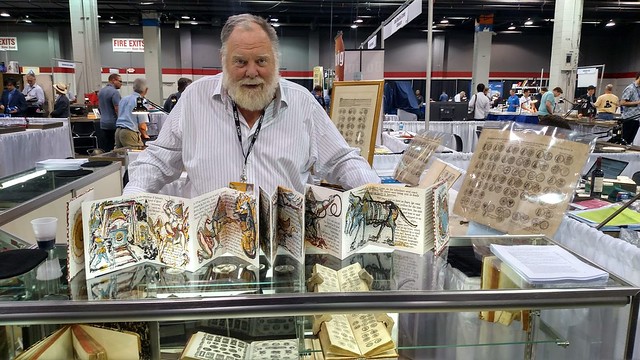
Gil Parsons with The Dollar From Death to Birth
Displayed above is a limited edition 2013 work by poet Arnie Passman and artist Art Hazelwood, The Dollar From Death to Birth. See my Numismatic Diary elsewhere in this issue for more on one of Parsons Books paper money offerings. For a copy of his fixed price list, contact Gil at parsonsb@sonic.net . -Editor

NEW BOOK: CHARLETON CANADIAN COINS 73RD EDITION
Although the publisher's site doesn't seem to have information on this yet, the Trajan Media Coin and Stamp Supplies site does list for preorder the new 2020 Charleton Canadian Coins book, available in both English and French versions. -Editor


First published in 1952, The Charlton Standard Catalogue of Canadian Coins has reported on all aspects of the Canadian numismatic scene, from the coinage of the French Regime to the business strikes of today. For more than 65 years Charlton coin catalogue has been the annual bible for coin collectors. With this new edition, prices have been updated to reflect current selling prices in the market place. The publisher has added several new varieties and many more images.
CANADIAN COINS Volume One, Numismatic Issues 73rd Edition, 2020
Mark Drake, Editor
Format: 7” x 9” Price: Can. 29.95 U.S. 27.95
Pages: 320 ISBN: 978-0-88968-416-4 (English)
Binding: Spiral
Please note the catalogue is set for release on August 30. Preorder today and save 20%. Offer expires Aug. 29.
For more information, or to order, see:
CANADIAN COINS Volume One, Numismatic Issues 73rd Edition, 2020
(https://coinstampsupplies.com/product/canadian-coins-volume-one-numismatic-issues-73rd-edition-2020/)
NEW BOOKS: STANLEY CANADIAN COIN PRICE GUIDES
Also available on the Trajan Media Coin and Stamp Supplies site are the 2020 editions of Bill Stanley's pricing guides on Canadian coins, tokens and paper money. -Editor
Author W. J. (Bill) Stanley has released his 2020 editions, including Breton Tokens; Canadian Circulating Coins, Tokens and Paper Money; Canadian Mint Collector’s Coins; and, the Canadian Coin Buyers Guide. The author says the majority of the valuations are based on recent auction sales.
All four books are published by the Canadian Wholesale Company, based in Paris, Ont.

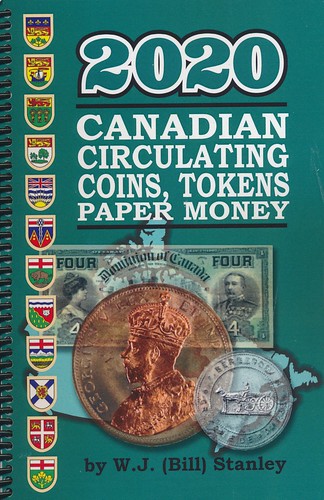
The 2020 Breton Tokens of Canada is the most comprehensive listings available in current catalogues. Coil bound to lay flat.
The 2020 Canadian Circulating Coins, Tokens and Paper Money. This year’s edition has been updated has been completely revamped and includes colour photographs. It is coil bound to lay flat.
It contains three sections:
- Canadian Circulating Coins
- Breton Tokens of Canada
- Canadian Paper Money
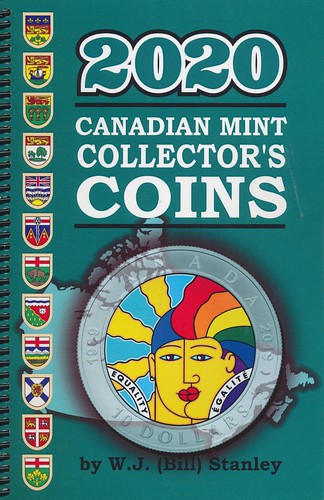

The 2020 Canadian Mint Collectors Coins contains coins made for collectors and not found in general circulation. Contains original issue prices, plus market prices. Coil bound to lay flat.
The 2020 Canadian Coin Buyers Guide is the most up-to-date buying guide on the market. Prices are based on current market auction and dealers selling prices all explained. Plastic coil binding to lay flat – heavy 100# text paper pages – fully illustrated.
For more information, or to order, see:
https://coinstampsupplies.com/product/2020-pricing-catalogues-for-canadian-coins-banknotes-tokens-and-rcm-collector-coins/
NEW BOOK: MONEY, MAYHEM AND MIGHT
Rick Lank of Hagerstown, MD submitted this announcement of Money, Mayhem and Might, a book he's written on Civil War numismatics with his wife Becky. It's available now for preorder at $40. -Editor
 Becky and I are now taking our first orders for
"Money, Mayhem and Might". At long last, the book is shaping up and taking its final form.
Becky and I are now taking our first orders for
"Money, Mayhem and Might". At long last, the book is shaping up and taking its final form.
Over the course of the last few months, we've been unearthing many new stories and have been connecting people and places, and causes and effects, that have shaped our money — all because of the events surrounding the U.S. Civil War and its aftermath.
We have been out on the road in the past spring and fall, sharing stories about coins and currency, and money and mayhem, to various groups in the mid-Atlantic area — mostly at large coin shows — and we've been meeting folks of all ages who have a real curiosity about the connections between the War of the Rebellion, and the legacy of how the Civil War is reflected in our wallets and pocket-change today.
We're shooting to have "Money, Mayhem and Might" ready and on the street by the last week of September!
Table of Contents
- Acknowledgements/Thanks
- Introduction / Ten Tumultuous Years, 1857 through 1867
- Glossary - A Readers guide to Terms and Slang of the Time
- A Parcel of Rogues in a Nation (Thanks Mr. Burns)
- What was in Your Wallet or Purse in the 1860s?
- Ready to Rumble; Ready for War
- No Small Change - Part A
- Fractional Currency
- No Small Change - Part B
- Queersmen, Boodle - runners and Koniackers
- "Taken in Trust" - 3 U.S. Mints held Hostage by the CSA
- The Gold Rush Down South Before the California Strike
- Tales About New Orleans and the Mint in the French Quarter
- Jefferson Davis's Talisman & the North's Mockery
- The Treasury Girls and the Legacy of Francis Spinner
- The National Bank Act and Amendments
- Joseph Wharton and the Nickel Revolution
- Talkin' Tokens
- In God We Trust vs. E Pluribus Unum
- Dead Presidents & Living Women
- Making Money the Old-Fashioned Way
- Printers of Money North and South
- Slavery Depicted on CSA Notes
- Hordes, Hoaxes and High Hopes
- The End of the Line — Literally for the CSA Treasury
- Dog Tags Made from U.S. Coins
- EPILOGUE
For more information, or to order, see:
Talisman & Coiner Productions, LLC (https://talisman-coiner-productions.us/)

NEW BOOK: PLAYING WITH MONEY
Spink has published a new book by Robert Bracey based on an exhibit of play money at the British Museum. -Editor
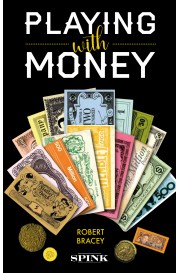 Playing with Money
Playing with Money
by Robert Bracey
RRP £25
SPECIAL PUBLICATION PRICE £20
Paperback with flaps
112 pages
ISBN: 978-1-912667-04-8
Published to coincide with an exhibition of the same name at the British Museum
In the early twentieth century there was a revolution in board games. Children’s games intended to teach morality were transformed into economic simulations aimed at adults. This book demonstrates how play and games reflect and shape our understanding of money, and explores the history of board games in the twentieth century. Why was a famous psychic so interested in the stock market? How did a feminist campaigner try to undermine capitalism with a game? And why has ‘German game’ become synonymous with a growing number of cafes all across the world dedicated to playing board games?
Playing with Money is published to coincide with an exhibition of the same name, which runs from 18th April 2019 to 29th September 2019 in Room 69a at the British Museum. Drawing on the museum's extensive collection of early print and ethnographic games and 20th century board games, the exhibition focuses on how games depict the economy and their role as educational tools.
To read a review from CoinsWeekly, see:
Homo Ludens - or why Toy Money belongs in the British Museum
(https://coinsweekly.com/homo-ludens-or-why-toy-money-belongs-in-the-british-museum/)
For more information on the exhibit, see:
Playing with money: currency and games
(https://www.britishmuseum.org/whats_on/exhibitions/playing_with_money.aspx)
For more information, or to order, see:
Playing With Money by Robert Bracey
(https://spinkbooks.com/index.php?route=product/product&path=59/&product_id=630)
NEW BOOK: MANAGING & SETTLING A NUMISMATIC ESTATE
The American Numismatic Association's numismatic estate guide is now available on Amazon. -Editor
 Learn How To Manage Your
Numismatic Estate.
Learn How To Manage Your
Numismatic Estate.
Many coin collectors - and family members who inherit coins and related numismatic items from a loved one - need help disposing of a collection. The American Numismatic Association's "Managing & Settling a Numismatic Estate" shares practical tips for coin collectors and their heirs. Discover valuable advice on...
- Creating a numismatic estate plan
- Caring for a coin collection
- Inventorying numismatic items and assessing value
- Disposing of a coin collection / numismatic inheritance
- Much more!
Order your copy now and ensure that your numismatic estate is in good order!
For more information, or to order, see:
Managing & Settling a Numismatic Estate: How to Preserve or Dispose of a Coin Collection
(https://www.amazon.com/Managing-Settling-Numismatic-Estate-Collection/dp/0896370321)
2019 NUMISMATIC LITERARY GUILD AWARD WINNERS
The Numismatic Literary Guild (NLG) is a separate organization from ours, the Numismatic Bibliomania Society (NBS). But we share a love of the numismatic hobby and numismatic research and writing in particular. This NLG press release lists the NLG award winners for 2019, announced at last week's NLG Awards LUnch at the American Numismatic Association World's Fair of Money in Rosemont. Congratulations to all of the winners. -Editor
The Numismatic Literary Guild (NLG), a nonprofit organization composed of editors, authors, writers, bloggers and content producers who cover news and feature stories about all forms of money, medals and tokens as collectibles, presented its annual awards for 2019 on Thursday, August 15, in Rosemont, IL. This year marked NLG's 51st anniversary.
For information about the NLG, visit www.NLGonline.org. A membership application is available online at www.nlgonline.org/NLG_Member_Form.pdf.
To be eligible for consideration in any of the 2019 Numismatic Literary Guild award categories, entries must have been published, released, or posted on the Internet between May 1, 2018 and April 30, 2019.
These are the 2019 winners:
BOOK OF THE YEAR
United States Proof Coins, Volume IV - Gold
John W. Dannreuther
BEST SPECIALIZED BOOK: UNITED STATES COINS
United States Proof Coins, Volume IV - Gold
John W. Dannreuther
BEST SPECIALIZED BOOK: WORLD COINS TO 1500
Coins of The Ptolemaic Empire, Part 1, Ptolemy I - Ptolemy IV
Catharine C. Lorber
BEST SPECIALIZED BOOK: UNITED STATES PAPER MONEY
Treasury Notes of The War Of 1812
Donald H. Kagin
BEST SPECIALIZED BOOK: TOKENS & MEDALS
So-Called Dollars From The Pacific Coast Expositions 1894-1962
Jeff Shevlin & William D. Hyder
BEST SPECIALIZED BOOK: NUMISMATIC INVESTMENTS
Pleasure & Profit
Robert W. Shippee
BEST SPECIALIZED BOOK: NUMISMATIC HISTORY OR PERSONALITIES
Bent, Holed & Folded
Michael Shutty, Jr.
NUMISMATIC COLUMNS OR ARTICLES: UNITED STATES COINS TO 1900
The Myth of The Continental Dollar
Erik Goldstein
The Numismatist
NUMISMATIC COLUMNS OR ARTICLES: UNITED STATES COINS 1901 TO DATE
The PCGS Meeting That Solved A Mystery
Donn Pearlman
PCGS Rare Coin Market Report
NUMISMATIC COLUMNS OR ARTICLES: WORLD COINS TO 1500
NGC Ancients
Numismatic Guaranty Corporation
NGC Enews
NUMISMATIC COLUMNS OR ARTICLES: WORLD COINS 1501 TO DATE
A Short History of The Long-Lived British Penny
Jim Wells
The California Numismatist
NUMISMATIC COLUMNS OR ARTICLES: UNITED STATES PAPER MONEY
Thinking About Images of Slavery
Steve Roach
Coin World
NUMISMATIC COLUMNS OR ARTICLES: WORLD PAPER MONEY
Counterfeit Detection
Paper Money Guaranty
PMG Enews
NUMISMATIC COLUMNS OR ARTICLES: TOKENS AND MEDALS
James Murdock Jr. - Ohio Die-Sinker
David E. Schenkman
The Numismatist
NUMISMATIC COLUMNS OR ARTICLES: SPOT NEWS, MARKETPLACE, ANALYSIS
Educational Exhibits at the 2018 ANA Show
Steve Roach
Coin World
NUMISMATIC COLUMNS OR ARTICLES: HISTORY OR PERSONALITIES
Historic Moment: Joseph J. Mickley's Musings About The First "Coin Convention"
Joel J. Orosz
The Numismatist
ED REITER MEMORIAL AWARD FOR BEST COLUMN OR SERIES
Tokens & Medals
David E. Schenkman
The Numismatist
JAMES L. MILLER AWARD FOR ARTICLE OR STORY OF THE YEAR
The Myth of The Continental Dollar
Erik Goldstein
The Numismatist
BEST INVESTMENT NEWSLETTER
Liberty's Outlook
Patrick A. Heller
BEST PROFESSIONAL PERIODICAL
Coin News
John W. Mussell, Editor
BEST CLUB OR NOT-FOR-PROFIT PERIODICAL
Journal of Early American Numismatics
Christopher Mcdowell, Editor
BEST ONLINE NEWS WEBSITE
Coinweek.com
Charles Morgan, Editor
BEST DEALER OR INDUSTRY WEBSITE
StacksBowers.com
BEST SOCIAL MEDIA PLATFORM OR COIN COLLECTOR FORUM
Instagram.com
NGCCoin
Paul Sandler, Editor Numismatic Guaranty Corporation
BEST BLOG
The Money Connoisseur
Scott A. Travers
BEST AUCTION CATALOG: UNITED STATES COINS
The Archangel Collection Of Colonial Coins & 1792 Coinage
Stack's/Bowers
BEST AUCTION CATALOG: WORLD COINS
The Morris Collection
Heritage Auctions
BEST AUCTION CATALOG: PAPER MONEY
The Joel R. Anderson Collection of United States Paper Money
Stack's/Bowers
BEST AUCTION CATALOG: BOOKS OR EXONUMIA
The John W. Adams Library
Kolbe & Fanning
Numismatic Booksellers
BEST AUDIO-VISUAL PROGRAM: RADIO
Things You Know That Just Aren't So...
Patrick Heller
BEST AUDIO-VISUAL PROGRAM: AUDIO
Numismatic Americana Through The Eyes of John Kraljevich
John Kraljevich & Charles Morgan
CoinWeek.com
BEST AUDIO-VISUAL PROGRAM: SHORT VIDEO Indian Peace Medals: Important And Historic Collectibles
Russ Augustin & Charles Morgan
CoinWeek.com
BEST AUDIO-VISUAL PROGRAM: LONG VIDEO 1792 - A Hub Story: How The First U.S. Mint Coinage Dies Were Made
CoinWeek.com
Bill Eckberg & Charles Morgan
BEST SOFTWARE OR APP
NGCCoin.com Mobile App
Numismatic Guaranty Corporation
LEE MARTIN FOUNDER'S AWARD FOR BEST ALL-AROUND PORTFOLIO
Steve Roach
THE RIBBIT
Ron Guth
THE CLEMY
Douglas Winter
For more information on the Numismatic Literary Guild, see::
https://www.nlgonline.org/

INVASION OF CHAMPAIGN VIDEO ON NEWMAN PORTAL
The latest addition to the Newman Numismatic Portal is a video of last week's "Invasion of Champaign." Project Coordinator Len Augsburger provided the following report. Thanks! -Editor
Invasion of Champaign Video
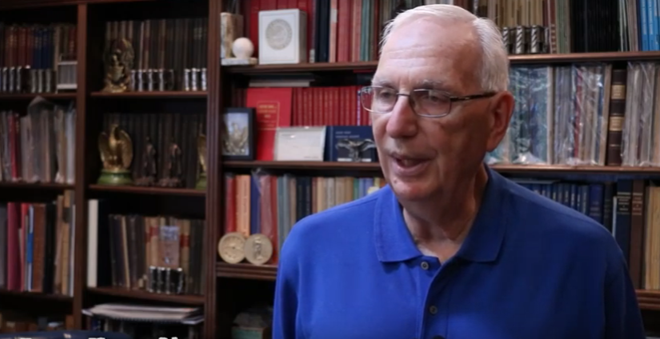
Dan Hamelberg in the “reading room” of his numismatic library
Under sponsorship of the Eric P. Newman Numismatic Education Society, Lianna Spurrier produced a short video covering the Dan Hamelberg library tour on August 18, 2019. Speakers include Dan Hamelberg, Wayne Homren, Chuck Heck, David Fanning, and Len Augsburger. Featured items are the John H. Hickox manuscript of An Historical Account of American Coinage, the Del Bland correspondence and inventory files, the rare 1881 edition of Frank D. Andrews’ work on middle and late date large cents, and the F.C.C. Boyd appraisal of the Col. E. H.R. Green collection.
Although all of these items are outstanding, they represent but a small portion of the entire library, which boasts many similar items of equal import. The Numismatic Bibliomania Society is grateful to Dan and Connie Hamelberg for opening their home to a group of fellow bibliophiles.
Link to “Invasion of Champaign” video on Newman Portal:
https://nnp.wustl.edu/library/book/567853
Link to Frank D. Andrews’ A Description of 268 Varieties of U.S. Copper Cents, 1816-1857 (J.N.T. Levick copy in the ANS library):
https://nnp.wustl.edu/library/book/562598
EARLY U.S. MINT FIXED PRICE LISTS ON NEWMAN PORTAL
Another great addition to the Newman Numismatic Portal is a group of early U.S. Mint Fixed Price Lists. Project Coordinator Len Augsburger provided the following report. -Editor

1862 fixed price list of U.S. Mint “Medal Dies of a Public Character”
As part of his work on “clandestine” Mint practices in the 19th century, Roger W. Burdette contributed to Newman Portal an 1859 memo from Mint Director James Ross Snowden outlining the offering of “master-coins,” which Snowden defines as coming from “polished dies” with “extra labor and care.” Collectors seem to like arguing over “proof” status for certain early U.S. issues, and, while this document won’t settle the debate, it is a step in the right direction. In any case, Director Snowden set the price for gold proof sets at $43.00 while silver sets were priced at $3.00.
Soon after, during the war, U.S.-issued greenbacks were no good at the Mint, and collectors wishing to purchase proof sets with currency paid a varying premium, depending on the latest fortune of the Union forces. Snowden further notes that the Mint will no longer trade pattern pieces in exchange for Washington medals needed for the Mint Cabinet, as most of the desired pieces had been acquired. Snowden’s book on Washington Medals, A Description of the Medals of Washington, was published shortly thereafter (1861).
Link to U.S. Mint Fixed Price Lists on Newman Portal:
https://nnp.wustl.edu/library/publisherdetail/512757
Link to Snowden’s A Description of the Medals of Washington on Newman Portal:
https://nnp.wustl.edu/library/book/567813
VIDEO: 2019 SUMMER FUN: YN HUNTER FALKMAN
These are selections from the David Lisot Video Library that feature news and personalities from the world of coin collecting. David has been attending coin conventions since 1972 and began
videotaping in 1985. The Newman Numismatic Portal now lists all David’s videos on their website at:
https://nnp.wustl.edu/library/multimediadetail/522852
Here's one featuring young numismatist Hunter Falkman. -Editor
Twelve Year Old Collector Shares What is Best About Coins.
VIDEO: 2:40.
 Hunter Falkman, Young Numismatist, David Lisot, Interviewer,
CoinTelevision.com. There are many reasons to collect coins. Perhaps the best reasons come from the youngsters in the hobby. Twelve year old Hunter Falkman was brought to the Summer Florida United
Numismatists Coin Convention by his grandfather. Hunter shares what is the best about coins.
Hunter Falkman, Young Numismatist, David Lisot, Interviewer,
CoinTelevision.com. There are many reasons to collect coins. Perhaps the best reasons come from the youngsters in the hobby. Twelve year old Hunter Falkman was brought to the Summer Florida United
Numismatists Coin Convention by his grandfather. Hunter shares what is the best about coins.
An excerpt of the video is available for viewing on the Coin Television YouTube Channel at:
https://youtu.be/i4LxUryBHMc
This video is a highlight from FUN Summer Coin Convention Highlights 2019

NOTES FROM E-SYLUM READERS: AUGUST 25, 2019
Tsundoku: Pile of Unread Books
For bibliophiles and readers in general, Len Augsburger passed along this Wikipedia definition. Thanks. -Editor
Tsundoku (Japanese: 積ん読) is acquiring reading materials but letting them pile up in one's home without reading them.
The term originated in the Meiji era (1868–1912) as Japanese slang. It combines elements of tsunde-oku (積んでおく, to pile things up ready for later and leave) and dokusho (読書, reading books). It is also used to refer to books ready for reading later when they are on a bookshelf. As currently written, the word combines the characters for "pile up" (積) and the character for "read" (読).
The American author and bibliophile A. Edward Newton (who would not have been aware of the term) commented on a similar state.
To read the complete article, see:
Tsundoku (https://en.wikipedia.org/wiki/Tsundoku)
VOCABULARY TERM: MACHINE ENGRAVING
Dick Johnson submitted this entry from his Encyclopedia of Coin and Medal Terminology. Thanks. -Editor
Machine Engraving. In the broadest sense, any engraving not done by hand, by any device other than a hand-held burin or graver. All machine engraving must have a pattern or template to control the cutting away of the metal surface which is accomplished by a CUTTING POINT, rotary milling bit, or laser. In contrast, hand die engraving places all control in hands and mind of the human engraver creating modulated relief in varying depth and shapes.
Mechanical minded people have attempted to mechanize the laborious task of engraving by hand for hundreds of years. By and large the French have been the most successful since the later part of the 18th century. However, inventors and mechanics have built mechanical engravers in Belgium, England, Russia, Germany, America and other countries.
By eliminating the tedious chore of hand engraving, the task of preparing dies, specifically, passed from the hand engraver to an artist, sculptor, or model maker to prepare the pattern and a craftsman to operate the machine. The artist is given the credit he or she is due for the design, however, only rarely have some machine engraved objects have been signed by both the artist and the machine operator. (Several medals for the Columbian Exposition of 1892 were signed by both artist and machine operator, for example.)
Despite attempts for over 200 years no one as yet has devised a machine to engrave what a human artist can do. An engraved design or die cannot be created from a concept, drawing, outline, photograph or grid, no matter how hard everyone has tried. An artist is required to create the design, the relief or the pattern. Machine engraving is only a tool to supplement such artistic endeavor, not to replace the human artist. The design must be filtered through the mind and talent of the artist.
Early mechanical die engravers. The first machine engravers were hardly more than cameo cutters or copying lathes at the end of the 18th century. They possessed an arm for reducing a bas-relief design with a cutting point that acted much like a lathe. As the pattern revolved the cutting tool was pressed in as far as the arm controlled by the pattern allowed. Pretty primitive.
Later models had a rotating cutting point which made the engraving machine a mechanically controlled milling machine. Many machinists attempted to further develop such a machine to the end of the 19th century, but the best die-engraving pantograph had been created by Victor Janvier in France and patented in 1899.
Modern pantographs are amazing machines. Not only can they reduce the complete model and cut a die to the required size, they can also vary the height of the relief, enlarge instead or reduce, change the polarity (a right-facing design can be changed to a left-facing design), or it can be programmed to add a die camber (raising the center slightly from the rim inwards).
Then it can start all over again and do the same in any other size within its ratio capabilities. An 8-inch pattern, for example, can be reduced to a 3-inch and 1 ½-inch dies for medals, and ?-inch die for charms. All made by this amazing engraving machine. It is understandable that every mint in the world possesses such a reducing machine. These included the Janvier – the preeminent engraving machine – but others as well. See pantograph.
Tracer controlled die engraving. Another form of die engraving by machine has been the use of the tracer controlled machine. From a hard line drawing, a cartoon, the operator pantographically reduces and, by a rotating cutter, cuts an outline design as the tracer is guided by hand over the outline of the design. At the operator’s option he can also outline the lettering.
The operator – or hand engraver – then routes out the dead metal from the part of the design so intended. At this point he must work the rest of the die by hand, creating he modulated relief for the devices, decorations, lettering and ornamentation. He then sharpens up the lettering and touches up the die as a finely hand worked stage. See Gorton.
Flat engraving and inscribing. For inscribing lettering on any flat surface (either on medals, trophies, nameplate or such) are the common engraving machines seen in jewelry and trophy house workrooms. These operate from template letters (matrixes) that are guided by hand with a stylus in the grooves of the template.
Early models with templates had only one size template for each typeface. These could be reduced, same size or enlarged on the flat engraving machine. A different matrix was required for each alphabet, particularly for foreign languages with different style letters. Sets of symbols were also available.
Computer inscribing. Templates have been completely eliminated by the new technology of computer inscribing, now available on modern engraving machines. Hermes, a firm formerly supplying mechanical engraving machines and templates is now a leading brand of computer engraving systems.
Hand engraving versus machine engraving. Hand engraving is, of course, more expensive than machine engraving and may be thought of as better or more attractive because of this. However, it depends upon the experience and talent of the hand engraver. It is also thought that machine engraving may be more uniform, since it is created from the same pattern letters. This is somewhat true. But here, again, the experience of the engraver – and the time required – are the deciding factors.
Hand engravers also have a wide selection of tools; because of this they can create far more variety in their engraving work. Machine engraving, for the most part, is limited to the router points of their machines. They can vary the shape or width of these, but, again, the end result may appear more mechanical, more uniform.
Finally, hand engraving can engrave in places that machine engraving cannot go; the edge of medals for example. In general, however, the diagnostic evidence for machine engraving is the uniformity of repeated elements, as lettering.
Looking for the meaning of a numismatic word, or the description of a term? Try the Newman Numismatic Portal's Numismatic Dictionary at: https://nnp.wustl.edu/library/dictionary
Or if you would like a printed copy of the complete Encyclopedia, it is available. There are 1,854 terms, on 678 pages, in The Encyclopedia of Coin and Medal Technology. Even running two a week would require more than 19 years to publish them all. If you would like an advance draft of this vital reference work it may be obtained from the author for your check of $50 sent postpaid. Dick Johnson, 139 Thompson Drive, Torrington, CT 06790.
ARTHUR ELBRIDGE MARKS (1853-1917)
 Arthur Elbridge Marks (1853-1917), was born on February 12, 1853,
at Yarmouth, Cumberland County, Maine, son of Elbridge Marks (1830-), a farmer, and Mary Adele Marks (1834-).
Arthur Elbridge Marks (1853-1917), was born on February 12, 1853,
at Yarmouth, Cumberland County, Maine, son of Elbridge Marks (1830-), a farmer, and Mary Adele Marks (1834-).
In 1860 he lived with his parents on the family farm in Penobscot, Hancock County, Maine. Later on he emerges as one of the early prominent collectors and dealers of Maine numismatic history.
He became a real-estate developer and construction company president specializing in building residential homes.
He was a contemporary of William Theodore Curtis (1849-1897), and Charles Burleigh (1855-1916), coin dealers in Portland, Cumberland County, Maine active in 1878 and 1880 respectively and Lt. Col. Charles E. Blunt, a collector of Portland, Cumberland County, Maine, active 1881, and Ferguson Haines (1840-1925) of Biddeford, York County, Maine.

Marks became a frequent correspondent of the Chapman Brothers beginning in the 1880's.
 In American numismatic history is is known simply as A. E.
Marks, Woodfords, Maine. Marks was a coin dealer who advertised selling early American copper cents in The Numismatist in August, 1892, on page 32. By this date he already prepared and devised
arranging select coins for sale in packets to be sent on approval for clientele. His inventory lists grew into his published FPL which seems to have first emerged probably sometime in either late
1895 or early 1896.
In American numismatic history is is known simply as A. E.
Marks, Woodfords, Maine. Marks was a coin dealer who advertised selling early American copper cents in The Numismatist in August, 1892, on page 32. By this date he already prepared and devised
arranging select coins for sale in packets to be sent on approval for clientele. His inventory lists grew into his published FPL which seems to have first emerged probably sometime in either late
1895 or early 1896.


He is ANA member no. 89.
His name appeared in the March 1892 issue of The Numismatist, in list no. 15, as number 431.
In 1894, he built the Edward E. Marks Home
He died at age 64 on July 30, 1917.
To read the complete article, see:
MARKS, ARTHUR ELBRIDGE
(https://sites.google.com/a/numismaticmall.com/www/numismaticmall-com/marks-arthur-elbridge)
The entire inventory of the Lupia Numismatic Library is for sale. Individual items will be available before the remaining archives are broken up into parcels sold at philatelic auctions in the U. S. and Hong Kong. Check NumismaticMall.com frequently as dozens of new items with estimates will be posted daily until everything is sold.
All inquiries will be given prompt and courteous attention. Write to: john@numismaticmall.com .
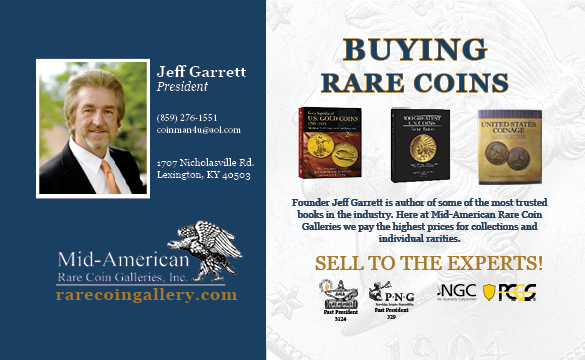
HARVEY STACK'S NUMISMATIC FAMILY, PART 51
The latest article in Harvey Stack's blog series focuses on the heady year 1969. Thanks, Harvey. -Editor
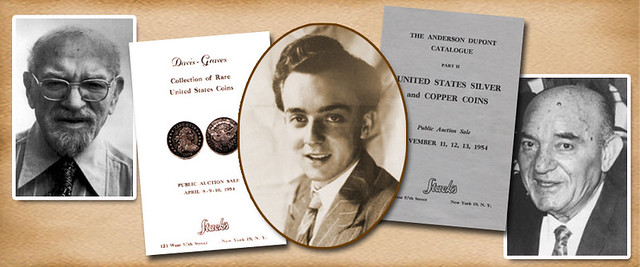
1969 was a pivotal year in numismatics as so many things came together to attract more people to the hobby
First of all, earlier coins found in circulation that were made of silver grew in value as precious metal, so that each coin was worth more than the face value. Simply speaking a silver dime was worth almost $1, a quarter $2.50 and a half dollar about $5. As the press constantly reported that these silver coins had such a premium, the treasure hunt was on in pocket change as well as for old coins in piggy banks or in cookie jars.
Numismatic publications, such as the weekly newspapers Coin World and Numismatic News and monthly magazines, reported on this growth of the precious metals market. The fact that there were more numismatic publications during this time as well as greater frequency of publication, enabled information to spread much more quickly and reach more people.
Speculation in precious metals became the "hobby of the times," causing gold and silver to advance in price. By 1968 the Treasury said it would "allow" the coins to be melted, (a factor thought illegal before) and the public became excited about searching for silver coins. There was also excitement over the increased precious metal value of silverware and silver trays and dishes that people had among their possessions.
The market for numismatic items grew more rapidly, as gold coins had become more collectible and a profit could be made on silver coins. The demand increased and values rose quite quickly. All these factors brought more and more people into the hobby and coin clubs, including the American Numismatic Association grew in numbers as the hobby became more popular.
This increasing market also caused some established collectors to decide that this was the time to sell. Some famous collections came to Stack's and we had the pleasure of presenting them at auction or of buying them outright. Our retail shop on 57th Street remained an attraction and many old and new collectors found time to visit and gather at our "club," to buy and sell, to talk coins or to attend our auctions. As always, a growing market meant that the number of coin dealers was increasing as well.
Beyond our continuing sale of the R.L. Miles Collection, Stack's was pleased to be able to offer many other exciting United States and world coin auctions during 1969. These auctions will be the focus of my next articles.
To read the complete article, see:
Harvey Stack Remembers: Growing up in a Numismatic Family, Part 51
(https://www.stacksbowers.com/News/Pages/Blogs.aspx?ArticleID=harvey-stack-remembers-51)
To read the earlier E-Sylum article, see:
HARVEY STACK'S NUMISMATIC FAMILY, PART 50 (https://www.coinbooks.org/v22/esylum_v22n32a24.html)
CANADIAN BANKING MEMORABILIA SOCIETY FORMED
This article from Canadian Coin News announces the formation of a new club: the Canadian Banking Memorabilia Society. -Editor

The Canadian Banking Memorabilia Society (CBMS) is looking to become the country’s newest national club, this focusing on a “largely overlooked genre of numismatics,” according to organizer Kevin Day-Thorburn.
After placing several three-line advertisements in the Atlantic Provinces Numismatic Association newsletter about a potential cheque collector’s club, Day-Thorburn was contacted by another collector, Stephen Oatway and the duo have started a Facebook page. The CBMS will soon begin publishing a bimonthly digital newsletter, which will be free until July 2020 at the Royal Canadian Numismatic Association (RCNA) Convention in Halifax, N.S., where the CBMS is also planning to host a meeting, establish an executive and “look into initiating modest dues,” Day-Thorburn said.
“The scope of this new club is far-reaching with lots of room for fresh research. Credit cards and bank cards are one example,” said Day-Thorburn, who was named a Fellow of the RCNA, which he also serves as an area director, at the association’s 2018 convention in Mississauga, Ont.
“The focus of the club will go beyond cheques, enabling everyone with an interest in banking memorabilia an opportunity to participate and contribute to a largely overlooked genre of numismatics. Nearly every collector of coins or paper money has picked up something that doesn’t quite fit but is still too cool or historic to pass on.”
“Mechanical banks, calendars, bills of exchange, and postal cards are just a few examples of other memorabilia,” said Day-Thorburn, who added, “Word is already spreading and the list of potential founding members is growing. We’re feeling very positive about this.”
For more information about the CBMS, visit facebook.com/bankingmemorabilia or contact bankingmemorabilia@gmail.com.
What a great idea! Many of us numismatists have accumulated banking-related antiques and ephemera. I collected bank bags, bank histories and a few coin banks over the years. It would be interesting to meet and trade with fellow collectors. Perhaps there will be an American Banking Memorabilia group someday. -Editor
To read the complete article, see:
Banking memorabilia collectors form new club
(https://canadiancoinnews.com/banking-memorabilia-collectors-form-new-club/)
JP KONING ON STIGMATIZED MONEY
JP Koning blogs about money and economics. I've missed some of his recent posts but have been wanting to mention this August 5th article about "Stigmatized money" - forms of payment that aren't universally accepted and are looked down upon by other parts of society. We've discussed some of these payment forms before and I've added links to earlier E-Sylum articles. -Editor
Some payments systems are so awkward they scare away the average user. The only people with the patience to stick around must have a motivation for doing so. These include ideologues with an ax to grind, hobbyists who happily embrace complicated features, and criminals/weirdos who are shut out of everything else.
Here are a few examples of awkward payments systems:
-Local Exchange Trading Systems, or LETS
-Bitcoin/Dogecoin
-Labor notes
-Stamp scrip
When usage of a payments system is confined to a narrow group of like-minded individuals, this may stigmatize these systems, scaring away mainstream users. Stigmatization only compounds the initial awkwardness. After all, if fewer venues accept the stigmatized payments option then it becomes harder for the small band of users to make purchases. A vicious circle has been created. Initial awkwardness leads to stigma which leads to more awkwardness etc.
While this vicious circle is the death knell for a payments system, it is less of a problem for other products. You can make a decent living by targeting a small niche of consumers, say communists who eat vegan food. Every big city needs a communist vegan restaurant. But a payments network is only as good as the size of the payments pathways that it facilitates. A payments entrepreneur won't get very far by building a platform that only allows communist vegans to pay other communist vegans.
How to evade the awkwardness-stigma spiral? What is needed is a frictionless, non-awkward payments system. With little to learn, everyone—not just nerds and those with an ax to grind—can quickly start using it. Think M-Pesa or Visa or Octopus.
Even the haters will get onboarded. Gold bugs and bitcoiners may rail against banks and fiat money. But because everyone else is using these relatively simple systems, the bugs and the bits have no choice but to go along. By bringing the vast hoard of normies on board along with the weirdos, these systems avoid all connotation. They are safe for broad consumption. No stigma can attach to them. And so the vicious awkwardness-stigma circle I described gets sidestepped.
To read the complete article, see:
Stigmatized money (http://jpkoning.blogspot.com/2019/08/stigmatized-money.html)
Local Exchange Trading Systems, or LETS
I'd argue that LETS are an example of a system that suffer from the awkwardness-stigma spiral. LETS are a pain to use. This article on the famous Comox LETS and its founder Michael
Linton, an earlier proponent of LETS, explains some of the problems. And so the only people who use LETS will be those willing to put up with the awkwardness: folks who self-identify as leftist with
anarchic views. Those who don't share those views might feel weird joining a LETS. So LETS remain small and fragile, or as Linton says, they're like "sandcastles on the beach."
To read the referenced LETS article, see:
Decades of documents: Michael Linton passes on LETS legacy
(https://www.comoxvalleyrecord.com/news/decades-of-documents-michael-linton-passes-on-lets-legacy/)
To read earlier E-Sylum articles, see:
ESTONIA'S BANK OF HAPPINESS ALTERNATIVE CURRENCY (https://www.coinbooks.org/esylum_v12n15a24.html)
LOCAL EXCHANGE TRADING SYSTEM (https://www.coinbooks.org/v22/esylum_v22n22a14.html)
Bitcoin/Dogecoin
You see the same awkwardness-stigma cycle at play in bitcoin. Bitcoin is an awkward payments medium. The stuff is so volatile that retailers don't like to accept it. Risk averse consumers
don't want to hold it. So only a subset of the population will ever feel comfortable using bitcoins for payments.
This subset has developed its own norms and codes. Bitcoin steak dinners are a good example. A large group of predominately male bitcoiners will get together to eat meat while avoiding vegetables, then broadcast it on Twitter...
I'm sure it's a lot of fun. But these sorts of traditions will inevitably be perceived as weird by the majority. And so the majority will go out of their way to avoid bitcoins for fear of being tarred as an oddball. Other niche groups who can't sympathize with male carnivores, say lesbian vegans, will avoid bitcoin payments on principal. This stigma cuts down on the potential pool of bitcoin payees, which only makes bitcoin more annoying to use.
Mastercarders don't have their own set of traditions. For instance, you won't see Mastercard users setting up meetups to eat organic food and talk about the latest development in tokenization technology. The Mastercard/Visa user-bases are devoid of culture and character. This lack of a class consciousness is one of the features that makes them such effective payments networks. Systems without norms and traditions never face the risk of falling into the stigmatization hole.
Facebook's Libra has attracted plenty of attention over the last few months. But Libra risk encountering the same awkwardness-stigma cycle as Bitcoin and LETS. Unlike other social media-based payments tools (Wechat, Kakao, Line etc), Libra's architects have chosen to create a new unit of account rather than marrying Libra tokens to existing units like the dollar or euro.
Cash
Konig notes that we're already starting to see this cycle ramping up against the use of cash. -Editor
The vicious awkwardness-stigma cycle has already started to hit cash. In places like Sweden, cash is being stigmatized. When the middle and upper class are convinced that only the poor and criminals use coins and banknotes, many of them will go out of their way to avoid using cash. Cash becomes "grungy and unsexy," as Brett Scott puts it. Unfortunately, an ever narrower base of cash users will only make the stuff more expensive for retailers to handle, leading to a rise in cashless stores (especially ones that cater to the rich), leading to more awkwardness and stigma, leading to less users, etc.
David Birch has an interesting parable from William Gibson's Count Zero that illustrates what happens when this stigmatization is brought to its logical conclusion. Basically, cash is still around in Gibson's imagined future, but it has disappeared from "polite society". And so the story's protagonist, Bobby Newmark, describes it as unspendable...

To read earlier E-Sylum articles, see:
SWEDEN'S NEAR-CASHLESS ECONOMY (https://www.coinbooks.org/v20/esylum_v20n39a29.html)
CHINA IS ALREADY LARGELY CASHLESS (https://www.coinbooks.org/v21/esylum_v21n01a36.html)
NEW JERSEY BANS CASHLESS STORES (https://www.coinbooks.org/v22/esylum_v22n12a32.html)
Labor notes
Labor exchange notes were only mentioned in passing, but are a recurring theme in economic history and popular collectibles today. I have several in my collection. See my Numismatic Diary elsewhere in this issue for a couple more American Labor Exchange notes. -Editor
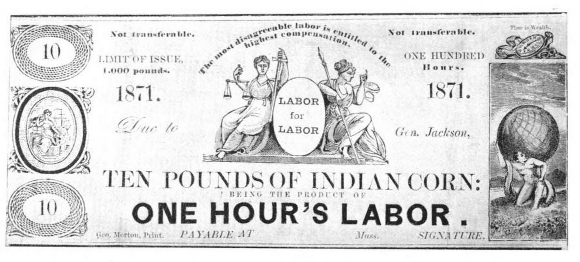

To read earlier E-Sylum articles, see:
THE LABOR EXCHANGE NOTES OF GIOVANNI DEBERNARDI (https://www.coinbooks.org/esylum_v15n51a15.html)
MORE ON LABOR EXCHANGE NOTES (https://www.coinbooks.org/esylum_v15n52a12.html)
LABOR EXCHANGE CURRENCY IN THE UNITED STATES (https://www.coinbooks.org/v20/esylum_v20n01a32.html)
MODERN-DAY TIME BANKS (https://www.coinbooks.org/v22/esylum_v22n17a27.html)
To read the complete article, see:
Stigmatized money (http://jpkoning.blogspot.com/2019/08/stigmatized-money.html)

TYRANTS OF THE SEINE EXHIBIT AT LONG BEACH
Here's the press release for the latest exhibit of coins from the Tyrant Collection. Bibliophiles note: printed catalogs of the exhibit are available. -Editor
Coins In Tyrant Collection Long Beach Display

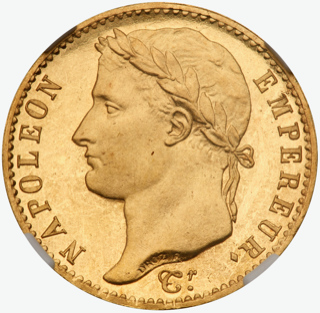
An exhibit of rare, historic French coins described as the best and most comprehensive ever displayed in the United States will be showcased from the extensive Tyrant Collection (www.TheTyrantCollection.com) at the September 5-7, 2019 Long Beach Coin, Currency, Stamp & Sports Collectible Expo (www.LongBeachExpo.com).
Entitled “Tyrants of the Seine,” this will be the fifth exhibition in a multi-year series of different displays of portions of the extensive Tyrant Collection, described as the world’s most valuable rare coin collection in private hands.
“This exhibit will have nearly 400 coins dating from 59 B.C. with the invading French tribes after the fall of Rome in 476 A.D. through the founding of the Carolingian Dynasty in the 7th century to modern coinage shortly before World War II. I can’t recall ever seeing a better exhibit of French coins outside of France,” stated Ira Goldberg President of Goldberg Coins and Collectibles, Inc. (www.GoldbergCoins.com) in Los Angeles, California.
“This impressive exhibit of many of the finest known rare French coins will be insured for $10 million for the September Long Beach display,” added Goldberg who is one of the numismatic professionals providing guidance in assembling the wide-ranging Tyrant Collection of superb quality, historic U.S. and world coins for its anonymous owner.
“The Tyrants of the Seine exhibit will include superb examples of almost every Friedberg number (from the Standard Catalog of World Coins) from the 13th century to 1936 reflecting the Tyrant Collection owner’s patience, ability and determination to collect historic French coins,” stated Yifu (Ivan) Che, numismatist at Goldberg Coins & Collectibles who is assisting in the cataloging of the impressive collection.
Exhibit highlights include:
• Gold Stater struck by the Parisii in Northern Gaul between 100 to 50 B.C.
• A rare George-Florin of Philippe VI struck in 1346.
• 1640 10 Louis d’Or ceremonial or presentation issue of Louis XIII.
• Historic gold Essai struck in the name of Austrian Emperor Francis I during the coalition’s occupation of France in April 1814.
• Napoleon’s 1815 Proof 20 Francs struck during the Hundred Days.
• 1889 Proof 100 Francs of the Third Republic.
The owner of The Tyrant Collection wants to remain anonymous while he shares the collection’s coins with the public for their educational value.
Visitors to the September 2019 Long Beach Expo exhibit (booth #807) can receive a free, illustrated educational booklet about this latest, amazing display. Detailed catalogs with information and illustrations about each coin in the “Tyrants of the Seine” exhibit will be available for $10 each.
The Long Beach Expo will be held in the Long Beach, California Convention Center at 100 S. Pine Ave. Public hours are Thursday and Friday, September 5 and 6, from 10 am to 7 pm, and Saturday, September 7, from 10 am to 5 pm.
For more information on the Tyrant Collection, see:
Tyrant Collection (http://thetyrantcollection.com/)
To read earlier E-Sylum articles, see:
TYRANT COLLECTION AT FEBRUARY 2018 LONG BEACH (https://www.coinbooks.org/v21/esylum_v21n02a22.html)
COINS OF THE TIGRIS AND EUPHRATES VALLEY (https://www.coinbooks.org/v21/esylum_v21n20a30.html)
ITALIAN COIN EXHIBIT AT FALL 2018 LONG BEACH (https://www.coinbooks.org/v21/esylum_v21n31a29.html)
WAYNE'S 2019 ANA DIARY: PART II
Thursday, August 15, 2019
Last week I used my Numismatic Diary to highlight NBS and other numismatic-literature related events at the American Numismatic Association World's Fair of Money in Rosemont, IL. This week
I'll round things out with some other activities, although I know I could never capture it all.
Some of the people I spoke to during the show but have not yet mentioned included Steve Hill of Sovereign Rarities in London, David Kahn, Ken Hallenbeck, Blaine and Ted Shiff of Cybercoins, Tony Terranova, John Kraljevich, Bob Rhue, Dave Wnuck, Steve Hayden, Alan Weinberg, George Cuhaj, Wayne Herndon, Julian Leidman, Rob Rodriguez, Tom Uram, and Jeff Garrett.
The first numismatic item I acquired was at face value, receiving this overstamped dollar bill in change at the snack stand. Was somebody going around spending these at the show?

"Republican Senators Are Spineless" overstamp on $1 bill
 I had a couple other U.S. notes with me to show people. They
were $20 and $100 star notes, also acquired at face value - from my local ATM machine. I met E-Sylum reader Terry Cole at the table of Alex Perkakis Coins & Currency, where a similar $20
star note was offered at $30. Nothing to get rich on, but still a fun circulation find.
I had a couple other U.S. notes with me to show people. They
were $20 and $100 star notes, also acquired at face value - from my local ATM machine. I met E-Sylum reader Terry Cole at the table of Alex Perkakis Coins & Currency, where a similar $20
star note was offered at $30. Nothing to get rich on, but still a fun circulation find.
Friday, August 16, 2019
At the NBS General Meeting Friday morning, Dave Alexander's wife gave me a nice addition for my convention badge - a Computer Geek ribbon! Thanks!
After I grabbed some lunch and dropped some things off at my hotel room and went back on the floor to visit more tables. This is when I got to meet Gil Parsons, whose table I wrote about in an earlier article in this issue.
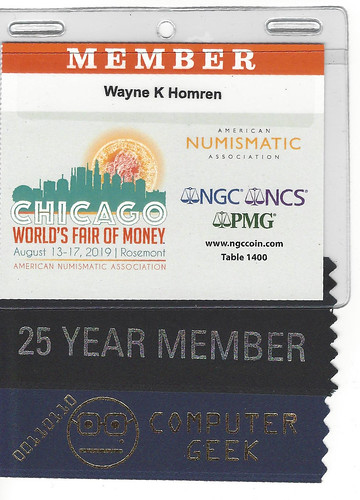
One neat item I was drawn to is something I already collect - Labor Exchange notes.

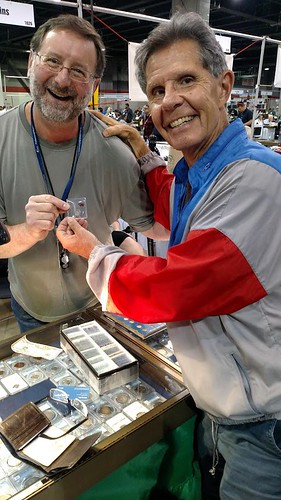 Among the last tables I visited was that of dealer David Kahn
of Maryland. I hadn't met him before, although I'd seen his ads around the web. I was introduced by NBS Treasurer Chuck Heck who was there buying a coin to complete the last hole in the
collection of a friend from his local coin club. Chuck is on the right, in front of Dave's table. I learned that Dave had been a visitor to Julian Leidman's coin shop when he was a young
collector.
Among the last tables I visited was that of dealer David Kahn
of Maryland. I hadn't met him before, although I'd seen his ads around the web. I was introduced by NBS Treasurer Chuck Heck who was there buying a coin to complete the last hole in the
collection of a friend from his local coin club. Chuck is on the right, in front of Dave's table. I learned that Dave had been a visitor to Julian Leidman's coin shop when he was a young
collector.
Dinner with Kellen Hoard
Friday night I joined Joel Orosz, Len Augsburger and his wife Debra for dinner with Kellen Hoard and his mom. We went to Café Touche, a nice French place a short ride from the convention center.
Conversation was all over the map, numismatic and otherwise. we all had a great time and lingered for quite a while after our meal was complete.
Saturday, August 17, 2019
Early Saturday morning I ran into John "JD" Dannreuther in my hotel lobby. We were both heading over to the Rittenhouse Society breakfast. On the way out the door I ran into my old friend
Larry Korchnak from Pittsburgh and we chatted for a minute.
Exhibits
When the show opened one of my first stops was the exhibit area. Stay tuned to future issues for more on the two great numismatic literature exhibits at the show. Here are a few of the many photos I
took. See the Flickr photo album for many more.
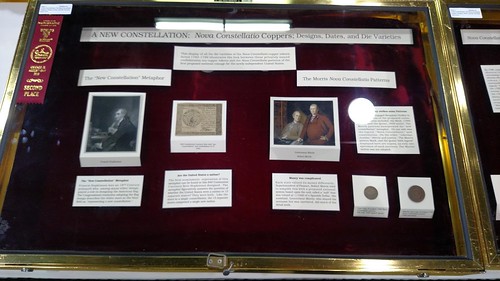
Nova Constellatio coppers

Crosby's Early Coins of America

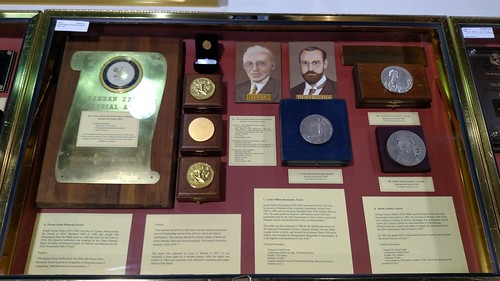
Numismatic Service Medals
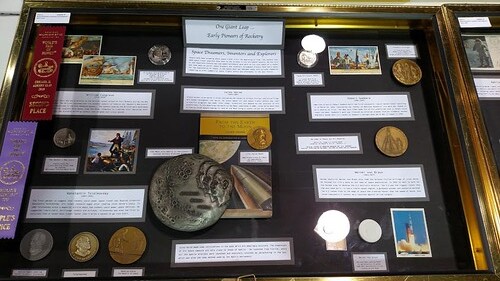
Pioneers of Rocketry

Counterfeit Detection
To view the complete photo album, see: 2019 ANA Exhibits (https://www.flickr.com/photos/coinbooks/albums/72157710529714837)
Kolbe & Fanning
I hadn't been able to get a photo at the booth of Kolbe & Fanning yet, so I stopped by for a minute.
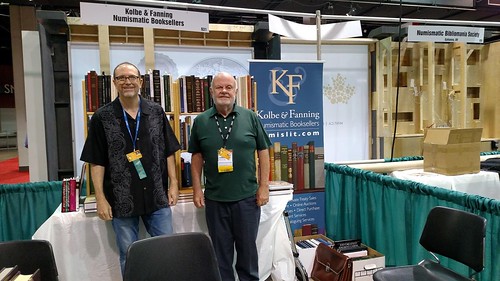
David Fanning and George Kolbe

Here George is speaking with Mark Ferguson; Kellen Hoard and Tom Harrison are at the NBS table next door.

Thinking...thinking...
Numismatic Cosplay
Sometime during the show I had a brief conversation with Charles Morgan of CoinWeek. He has a number of thoughts on increasing interest and participation in the hobby of numismatics. I had
conversations with others at the show as well, and many dovetail well with my own belief that the coin show is far from dead. Attendance and participation may be declining due to encroachment of
internet commerce, but there is no substitute for in-person interactions, and shows can be the focal point for that if they morph with the times. People need a reason to look up from their screens
and go see other people. They want experiences, and geeky fan conventions such as Comic-Con, DragonCon, Animecon and of course, the Official Star Trek Convention deliver that in spades. So what can
coin conventions do to spice it up?
I don't have any easy answers, but one great example is Pat McBride of the Pennsylvania Association of Numismatists who attended as Benjamin Franklin. Here are some great convention photos Pat posted on his Facebook feed.
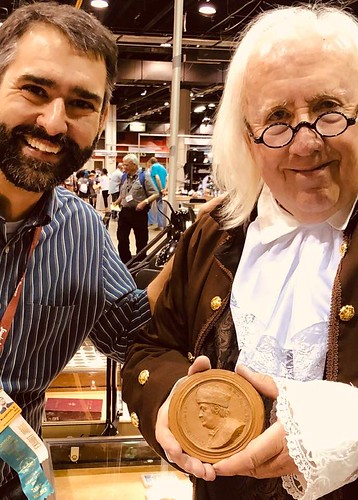

LEFT: "Ben" with John Kraljevich and a terracotta Franklin medallion by Nini
RIGHT: "Ben" with a draft for 75 pounds that he signed in 1771
And here's "Ben" with Dennis Boggs, who portrayed Abe Lincoln. What a great team!
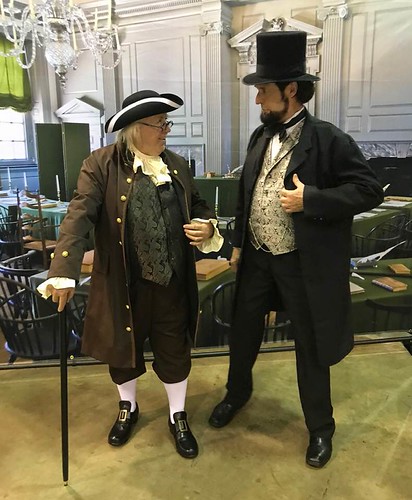
Dinner with Eric Schena
I spent most of Saturday afternoon and evening working on The E-Sylum at my hotel. I learned that my Nummis Nova pal Eric Schena was available and the two of us hooked up for dinner. We walked
over to the restaurant plaza behind our hotels and had a nice meal at the Adobe Gilas Mexican restaurant. We had a great conversation about the show and numismatics in general.
Sunday, August 18, 2019: The Invasion of Champaign
The highlight of my own in-person experiences at the show was attending the long-anticipated "Invasion of Champaign" on Sunday, a visit sponsored by NBS to the numismatic library of Dan
Hamelberg in Champaign, IL.
My day began with some work on The E-Sylum with the noise of a heavy rainstorm in the background. I hoped it would let up by 9am, when I had to get in the van over at the Hilton Hotel. No such luck. The rain continued pouring in bucketfuls. I was especially dismayed to see cars on the main road splashing more than enough water over the sidewalk for a head-to-toe soaking. Improvising an alternative, I wended my way through the substantial landscaping in front of the row of hotels across from the convention center. It was wet and a little muddy, but I encountered no corpses, hobo camps or other obstacles.
Shortly before 9am I climbed into our rented white van which would be driven by Len Augsburger with his wife Debra navigating from the front passenger seat. I sat in the middle next to Jan Monroe. In the back were Chuck Heck and Jeff Dickerson. Other folks drove there on their way home from the convention. Here's the full list of attendees:
Len Augsburger and his wife Debra Kurtz,
Mike Clark,
Jeff Dickerson,
David Fanning,
Tom Harrison,
Chuck Heck,
George Kolbe and his friend Betty Lowery,
Jan Monroe,
Dave Perkins, and
Garrett Ziss.
Dan's wife Connie was on hand as well as videographer/photographer Lianna Spurrier with her father acting as escort and assistant. I took a ton of photos as well. Not being smart enough to put my phone in airplane mode or ask Dan for a WiFi password, my phone wore itself out uploading backups of my photos and I had to recharge it multiple times. But I captured many great photos, and over fifty of them are available in an NBS Flickr archive album. Here are a sampling of my people shots and "shelfies". For more, see the full photo archive and Lianna's video on the Newman Numismatic Portal, referenced in the earlier article in this issue.
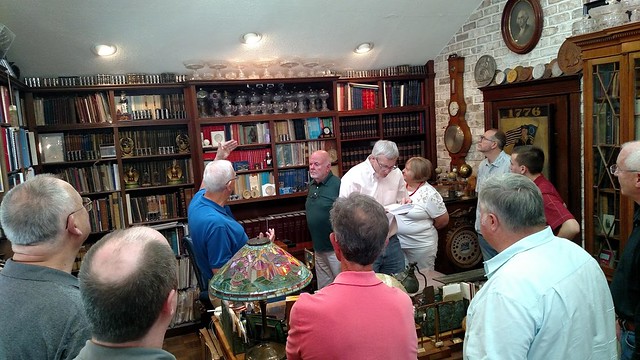


Tom Harrison and Garrett Ziss
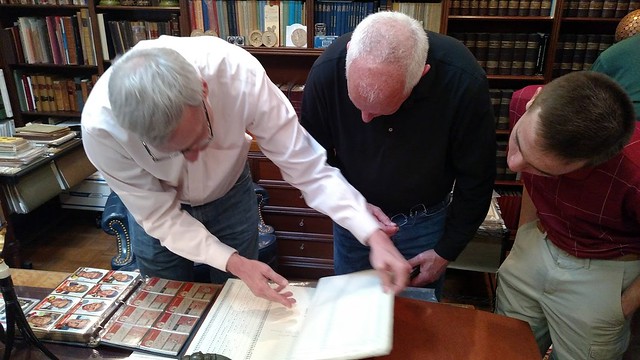
Len Augsburger, Dave Perkins, Garrett Ziss

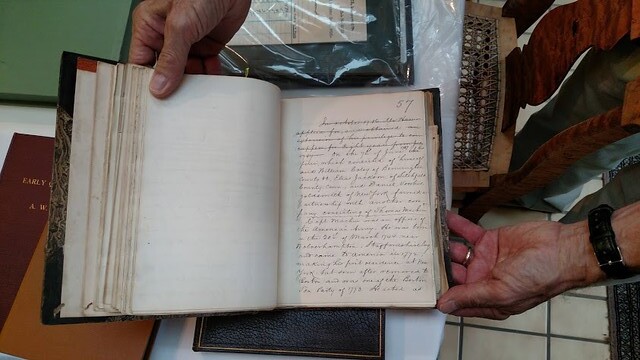
The Hickox manuscript of An Historical Account of American Coinage
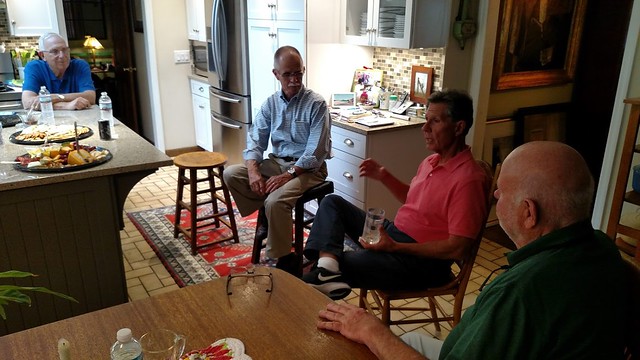
Dan Hamelberg, Tom Harrison, Chuck Heck, George Kolbe

One of many "shelfies"

Our dried-out van before heading back to Rosemont
What a great event! I can't thank Dan and Connie enough for opening their home to us and making the wonderful treasures of Dan's numismatic library available for close inspection. I was snowblind in minutes, overwhelmed by one great rarity after another. Wow! Please do review the photos and video for much more than I can convey in this small space.
Thanks, Dan!
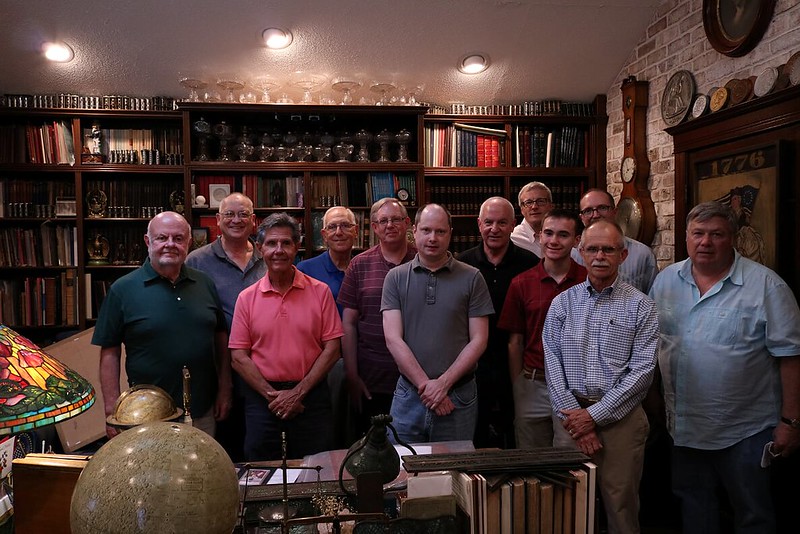
The Invasion of Champaign
FROM LEFT TO RIGHT: George Kolbe, Jan Monroe, Chuck Heck, Dan Hamelberg, Wayne Homren, Jeff Dickerson, W. David Perkins, Len Augsburger, Garrett Ziss, David Fanning (in back), Tom Harrison (up front), and Mike Clark.
To view the complete album, see:
2019 Invasion of Champaign (https://www.flickr.com/photos/coinbooks/albums/72157710529043808)
To watch the complete video, see:
https://nnp.wustl.edu/library/book/567853
Rush's Thunder Clappers
My trip home Monday morning was uneventful and almost as smooth as my trip to Rosemont. I grabbed lunch on my way home from the airport and read a chapter or two from a book I'd recommended to
Pat McBride for his research on Ben Franklin. it's How the Post Office Created America by Winifred Gallagher (Penguin Press, 2016). The title could be seen as a fanboy stretch, but the
author makes a very convincing case that the colonial postal system was a premeditated and necessary utility which brought the disparate and far-flung young states together and weaned them from
dependency and allegiance to the crown.
One of the architects of the postal system (in addition to printer and Postmaster Benjamin Franklin) was Benjamin Rush, known to numismatists as Treasurer of the U.S. Mint from 1797 to 1813. Rush championed many causes, but his greatest legacy may well have been his support for the post office in order to foster public education.
But I'll finish with this interesting and totally unrelated tidbit I learned from the book:
His modern reputation ironically rests on his brief service as the Continental Army's surgeon general, yet he was an inept doctor who relentlessly purged and bled his patients, not infrequently to death. (The high mercury content of his popular Bilious Pills, laxatives also known as Rush's Thunder Clappers, later helped researchers trace the path of the Lewis and Clark expedition.)
To read the earlier E-Sylum articles, see:
WAYNE'S 2019 ANA DIARY: PART I (https://www.coinbooks.org/v22/esylum_v22n33a16.html)
THE INVASION OF CHAMPAIGN (https://www.coinbooks.org/v22/esylum_v22n33a17.html)

HAROLD II SILVER PENNY DISPLAYED
A rare silver penny of Harold II is on display along with three other ancient treasures found near Hertfordshire, England. -Editor
 A silver coin which links England's last Anglo-Saxon king with
Bishop's Stortford now has a permanent home in Saffron Walden Museum.
A silver coin which links England's last Anglo-Saxon king with
Bishop's Stortford now has a permanent home in Saffron Walden Museum.
The Harold II penny will go on show for the first time on Saturday August 24 at the north-west Essex archive along with three other ancient treasures unearthed in the district.
The monarch defeated at Hastings by William the Conqueror in 1066 is rumoured to be buried under the floor of St Michael's Church in Windhill.
The coin, found in the Ugley area, is very rare because Harold Godwinson ruled for less than a year. He succeeded Edward the Confessor and reigned from January 6, 1066, until his death at the hands of the Norman invaders on October 14 that year.
His mistress, or common-law wife, was the first Saxon owner of the Manor of Esterteferd (Stortford), Eddeva Pulchrima. She was a renowned beauty, sometimes called Edith the Fair or Edith 'Swan-neck'.
The couple had children before he made a politically expedient marriage to Ealdgyth, widow of the Welsh king, Gruffydd.
To read the complete article, see:
Silver penny linking Bishop's Stortford to last
Anglo-Saxon king goes on show for first time (https://www.bishopsstortfordindependent.co.uk/news/uttlesford-residents-raise-cash-to-buy-stortford-king-harold-iis-silver-penny-9080012/)
2020 BASKETBALL COMMEMORATIVE COINS
Lou Golino published this article on Coin Update about the 2020 basketball commemoratives. Here's an excerpt - the the complete article online. -Editor
Next year coin collectors will have the opportunity to add a third dome-shaped U.S. commemorative coin to their collections following the 2014 Baseball Hall of Fame and 2019 Apollo 11 programs. The familiar trio of a clad half dollar, silver dollar, and gold $5 coin will be issued to mark the 60th anniversary of the founding in 1959 of the Naismith Basketball Hall of Fame in Springfield, Massachusetts.
James Naismith was a Canadian-American physician who invented basketball and had a strong commitment to the values of the game (which include respect, teamwork, perseverance, honesty, etc.).
 Don Senecal, who has served as the Hall of Fame’s Chief Financial Officer and Vice
President for Finance since 1998, said the organization is very excited about the forthcoming U.S. Mint coin program, which he anticipates will be popular with basketball fans. Like the HOF’s
president, John Doleva, he previously worked for Spaulding Sporting Goods.
Don Senecal, who has served as the Hall of Fame’s Chief Financial Officer and Vice
President for Finance since 1998, said the organization is very excited about the forthcoming U.S. Mint coin program, which he anticipates will be popular with basketball fans. Like the HOF’s
president, John Doleva, he previously worked for Spaulding Sporting Goods.
Mr. Senecal said the proposed designs, which will be shared by each of the coins, are “very artistic” and that during meetings of the coin design review committees this summer he indicated a preference for the concave obverse design of three players (one male, one female, and one in a wheelchair) reaching for a basketball.
This design was also the recommendation of both the Citizens Coinage Advisory Committee and the Commission on Fine Arts. He likes the way the design represents “the diversity of the game — one that anyone can play” — and the way the design emphasizes the inclusiveness of basketball in a way that a design showing only male players would not. As for the two convex reverse designs being considered, he said he likes the one with the basketball and net, also favored by the CFA. The CCAC prefers one that shows the side of a basketball.
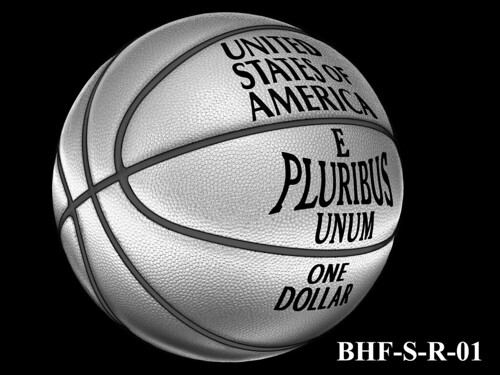
To read the complete article, see:
Naismith Basketball Hall of Fame plans year-long promotion of
2020 basketball commemorative coins (http://news.coinupdate.com/naismith-basketball-hall-of-fame-plans-year-long-promotion-of-2020-basketball-commemorative-coins/)

BOB COUSY AWARDED MEDAL OF FREEDOM
Here's an Associated Press story on this week's warding of the Presidential Medal of Freedom to basketball star Bob Cousy. -Editor

President Donald Trump presented 91-year-old basketball legend Bob Cousy with the Presidential Medal of Freedom on Thursday, praising the Boston Celtics star as "one of the all-time greats in the history of sports."
Cousy played for the Celtics from 1950 to 1963, winning six league championships and the 1957 MVP title. The Bob Cousy Award, given to the country's best point guard in men's college basketball, is named for him. He is a member of the Naismith Memorial Basketball Hall of Fame and played a pivotal role in founding the NBA Player's Association.
After hanging up his No. 14 jersey, the 13-time NBA All-Star went on to coach basketball at Boston College.
"This acknowledgment allows me to complete my life circle," Cousy said during the Oval Office awards ceremony. "I can stop chasing a bouncing ball. The Presidential Medal of Freedom allows me to reach a level of acceptance in our society I never once ever dreamed of."
Trump spoke of Cousy's childhood during the Great Depression and discovering his talent for basketball at a young age. The president said Cousy never forgot his first mentor's advice to never be predictable, and jokingly added: "Hey, I've heard that lesson, too."
The president recognized Cousy's achievements on and off the court, lauding his support for underprivileged young athletes and speaking out against racism.
Cousy, who is white, ardently supported his black teammates who faced discrimination during the civil rights movement. Still, Cousy lamented in Gary Pomerantz's biography "The Last Pass: Cousy, Russell, the Celtics, and What Matters in the End," that he didn't do more for his black teammates, including 2011 Medal of Freedom recipient Bill Russell.
The Medal of Freedom, the nation's highest civilian honor, celebrates individuals for their "especially meritorious contribution to the security or national interests of the U.S., to world peace, or to cultural or other significant public or private endeavors."
Trump credited West Virginia Sen. Joe Manchin for suggesting the medal be given to Cousy.
To read the complete article, see:
Bob Cousy receives Presidential Medal of Freedom
(https://www.nba.com/article/2019/08/22/bob-cousy-receive-presidential-medal-freedom)
Same Associated Press story, different photo on the Los Angeles Times. -Editor

To read the complete article, see:
Trump awards Medal of Freedom to NBA star Bob Cousy
(https://www.latimes.com/sports/story/2019-08-23/bob-cousy-trump-medal-of-freedom)
LOOSE CHANGE: AUGUST 25, 2019
Here are some additional items in the media this week that may be of interest. -Editor
The Big Five U.S. Coins
Martin Kaplan passed along this NGC blog article by Jeff Garrett. -Editor
When I started my full-time career in numismatics around 1977, numismatic rarity was measured against five coins. Everything else was compared with them and was worth considerably less.
The top three coins at the time were the:
- 1804 Silver Dollar
- 1913 Liberty Nickel
- 1894-S Barber Dime
The next tier consisted of the 1876-CC Twenty Cent piece and the 1838-O Half Dollar.
All five of these issues are featured prominently in my book, 100 Greatest United States Coins. The 1804 Silver Dollar consistently ranked No. 1 or 2 among polls of dealers.
To read the complete article, see:
Jeff Garrett: The Big Five Coins Everyone Covets (https://www.ngccoin.com/news/article/7682/)
Dave Bowers at the ANA
Here's a Coin Update article by Dave Bowers on last week's ANA convention. -Editor
To read the complete article, see:
Bowers on collecting: Here and there at the ANA convention
(http://news.coinupdate.com/bowers-on-collecting-here-and-there-at-the-ana-convention/)

